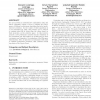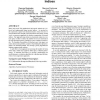412 search results - page 7 / 83 » Ranked Join Indices |
GECCO
2008
Springer
13 years 7 months ago
2008
Springer
An open problem in multiobjective optimization using the Pareto optimality criteria, is how to evaluate the performance of different evolutionary algorithms that solve multi– o...
IPM
2006
13 years 6 months ago
2006
Similarity calculations and document ranking form the computationally expensive parts of query processing in ranking-based text retrieval. In this work, for these calculations, 11...
ICDE
2009
IEEE
14 years 8 months ago
2009
IEEE
Abstract-- Similarity join is a useful primitive operation underlying many applications, such as near duplicate Web page detection, data integration, and pattern recognition. Tradi...
DASFAA
2006
IEEE
14 years 22 days ago
2006
IEEE
An important database primitive for commonly used feature databases is the similarity join. It combines two datasets based on some similarity predicate into one set such that the n...
CIKM
2011
Springer
12 years 6 months ago
2011
Springer
Many large-scale Web applications that require ranked top-k retrieval are implemented using inverted indices. An inverted index represents a sparse term-document matrix, where non...


